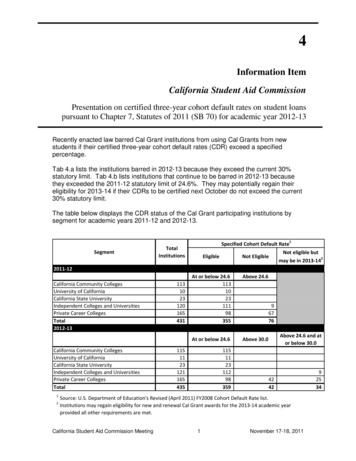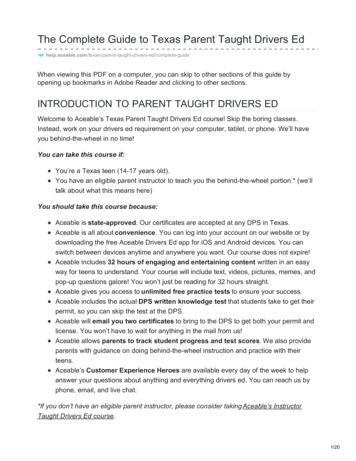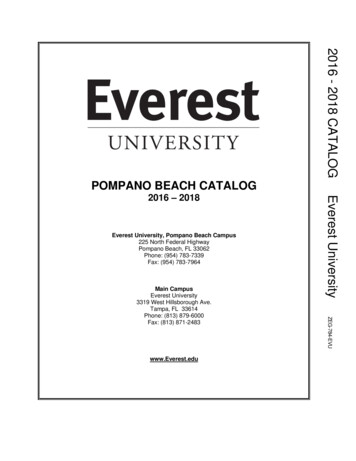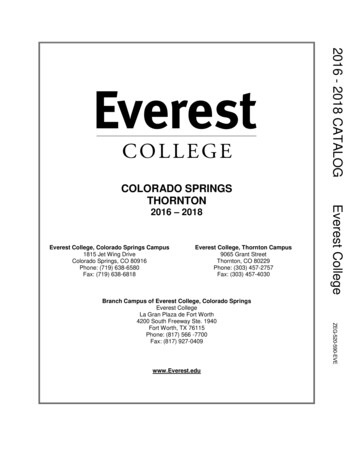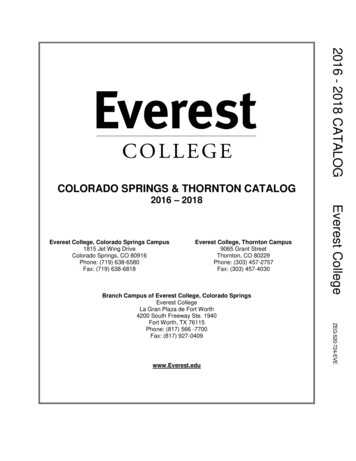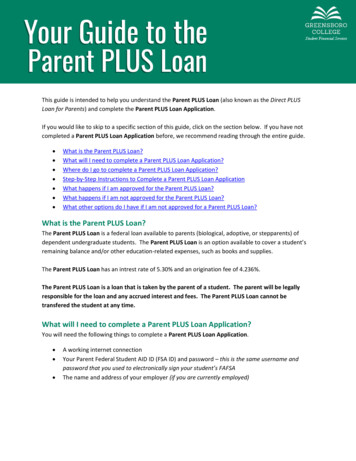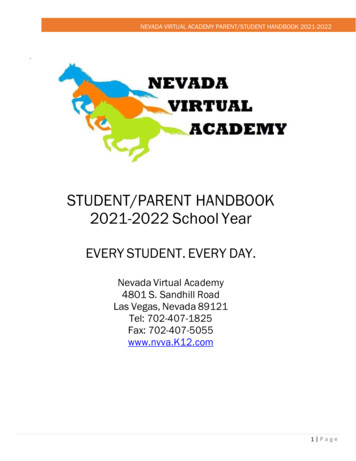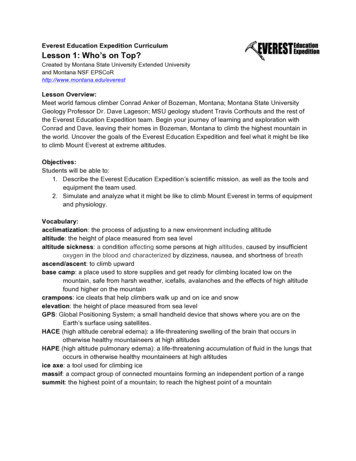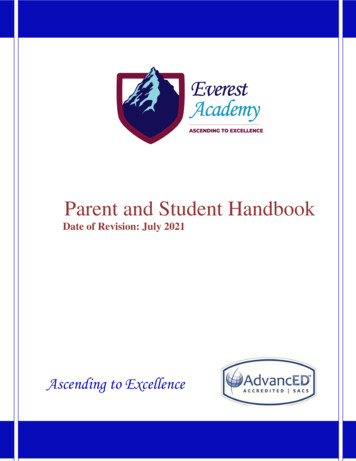
Transcription
Parent and Student HandbookDate of Revision: July 2021Ascending to ExcellenceAn Affiliate of Dar ul ArqamAscending to Excellence
Table of ContentsWELCOME TO EVEREST ACADEMY . 6Mission & Vision . 7IEIT Locations . 8Academic Calendar . 9OPERATIONAL POLICIES & PROCEDURES . 10Attendance & Absenteeism Policy . 10Missed Assignments and Grading Procedures . 10Tardiness . 12Cell Phone Policy. 12Discipline Policy . 12Section 1: Introduction. 12Section 2: Policies and Information: Maxims of Discipline . 13Section 3: Inappropriate Conduct . 14Section 4: Corrective Measures . 14Section 5: Disciplinary Interventions. 15Dress & Hygiene Policy. 17General Guidelines: . 17Pre-kindergarten Dress Code: . 17Grades DK-8 Dress Code: . 17School Spirit and Casual Dress Days: . 17Consequence for Violation of Dress Code: . 18Drop Off & Dismissal Procedures . 18Expected Student Behavior . 19Enrolment Policy . 19Required Documents . 20Prekindergarten Program . 20Fee Schedule . 21Field Trips . 22Grading & Promotion Policy . 23STAAR Exemption & Graduation Policy. 23Extra Credit . 24Everest AcademyParent and Student HandbookPage 2
Honor Roll . 24Report Cards . 24Transcript Legends. 24Expectations . 25Acceptable Use Guidelines . 25Unacceptable Conduct . 26Consequences for Noncompliance to Acceptable Use Policy . 26Hours Of Operation. 27P. E. & Outdoor Play . 27Outdoor Safety . 28Exemption from P. E. and Outdoor Play: . 28Photography & Publicity. 28Plagiarism . 28Rest & Nap Time . 29Student Lockers . 29Textbook Policy . 30Use of Videos . 30Withdrawal Procedure . 31HEALTH & SAFETY POLICIES . 32Accident/ Emergency Procedures for an Injured Child . 32Administration of Medication . 32Building & Playground Rules . 32Character Education . 33Introduction . 33Why is Character Education crucial and urgent today? . 33Eleven Principles of Effective Character Education . 34Foundations and Underlying Principles of Character Education:. 34The 7 E's of Teaching a Character Trait by Dr. Thomas Lickona . 34Everest Academy Character Education Program . 34Monthly Character Traits . 35Crisis Management Plan . 39Overview . 39Everest AcademyParent and Student HandbookPage 3
Current Safety and Security Measures . 39Fire Safety . 41Disaster Management. 42Inclement Weather Policy . 44Immunization . 45Minimum Vaccine Requirements for Texas Children . 45Mandatory Reporting of Child Abuse. 46Out-of-Country Travel Policy . 46Sickness Policy . 47Disease Control Measures. 47PARENT INVOLVEMENT . 50Parent Involvement Policy . 50Parent Responsibilities . 50Authorization for Pick Up. 51Parents under the influence of drugs or alcohol. 51Legal Custody . 51Birthdays & Other Celebrations. 52Observance of Holiday Celebrations . 52Contact Information . 52Communication with Parents . 52Grievance Policy . 53Homework Policy . 53Definition of Homework . 53Purpose of Homework . 53Responsibility of the Student . 54Responsibility of the Parents . 54Responsibility of the Teacher . 54Responsibility of the Administration . 55Late Work Policy . 55Homework Help Resources . 55Lunch & Snack Procedures . 56Lunch and Recess Detention. 56Everest AcademyParent and Student HandbookPage 4
Messages for Staff. 56Parent Teacher Conferences . 57Parent & Student Code of Conduct . 57Consequences . 58Student's Personal Property . 59Transportation . 59COVID-19 PROTOCOLS . 60Table of Contents . 61Document Overview . 62Health Protocols . 63Social Distancing in School Environment . 71Attendance, Extra-Curricular, Co-curricular Guidelines . 73Student Support Programs . 75Mitigation Strategy . 76References . 77Everest AcademyParent and Student HandbookPage 5
WELCOME TO EVEREST ACADEMYEverest Academy is a full-time private Islamic School located at 610 Brand Lane, Stafford, Texas.Neighboring cities include Sugar Land, Missouri City, and Houston. Everest Academy falls underthe jurisdiction of both IEIT (Islamic Education Institute of Texas) and ISGH (Islamic Society ofGreater Houston). It is accredited by AdvancED, SACSCASI, Texas Education Agency (TEPSAC)and CISNA; and is a member of the Islamic Schools League of America, and Tribes LearningCommunity.Everest Academy opened its doors in August 2007 with a nominal number of students. The schoolhas made remarkable progress in a relatively short span of time. The over 33,000 square feet, stateof the art, modern building was built in several phases. The first phase of the facility was 6000 square feet and was built specifically to serve as an elementary school. In 2009, an additional 7,500 square-feet was added to include early childhood classrooms, a multi-media library and an Arabiclab. In 2014, Everest Academy has added another 20,000 square feet extension, which includes anindoor PE area, Science lab, Hifz lab and classrooms for middle school students. The school isfurnished with modern amenities including computers, smart boards, and other audio, video andvisual teaching-aids.Our qualified administrators and teachers are dedicated to using best practices and resources toprovide instruction, inspire students to achieve academic excellence, and instill high moralstandards. These key tenets are at the heart of Everest Academy’s mission and truly prepare studentsfor the challenges of living in the 21st century as successful Muslim Americans.We invite you to contact us to learn more about our school. The opportunities for student successat Everest Academy are plentiful. We have the resources, expertise, and a mission-drivenphilosophy to offer a school setting that is truly unique, wholesome, and exciting.Everest AcademyParent and Student HandbookPage 6
Mission & VisionMISSION STATEMENT“Everest Academy shall strive for excellence in preparing its students fortomorrow’s challenges and for the Hereafter by providing them with an exceptionalacademic experience in an Islamic environment thereby empowering them to becomesuccessful Muslim Americans.”OUR MOTTOAscending to ExcellenceOUR VISIONVision 1: Students are prepared for tomorrow’s challenges through academic excellence.Vision 2: School provides a stimulating and wholesome environment based on the principles ofIslam.Vision 3: Students are successful and exemplary citizens.Everest AcademyParent and Student HandbookPage 7
IEIT LocationsCORPORATE OFFICE6671 Southwest Freeway, Suite 620Houston, TX 77074Phone :281-502-8310Fax: 281-605-5666EVEREST ACADEMY610 Brand Lane,Stafford, Texas 77477Phone: (281) 261 - 3030Fax: (281) 806 - 5944www.Everest-Academy.comDARUL ARQAM NORTH11815 Adel RoadHouston, Texas 77067Phone: (281) 583- 1984Fax: (281) 440- 8024www.darularqamnorth.comDARUL ARQAM SOUTH EAST8830 Old Galveston RoadHouston, Texas 77034Phone: (713) 948 - 0094Fax: (713) 948 - 0094www.southeast.darularqamschools.orgILM ACADEMY1209 Conrad SauerHouston, TX 77043Phone: (713) 464-4720 ext. 300Fax: (713) 464-4720www.ilmacademy.orgHOUSTON PEACE ACADEMY16700 Old Louetta Rd,Spring, TX 77379Phone: (281) 257-8988Fax: (281) 257-8981www.houstonpeace.orgEverest AcademyParent and Student HandbookPage 8
Academic CalendarEverest AcademyParent and Student HandbookPage 9
OPERATIONAL POLICIES & PROCEDURESAttendance & Absenteeism PolicyAll students are expected to attend school regularly, unless prevented by acceptable reasons perschool policy.Acceptable and excused absence may be due to personal illness, sickness or death in the immediatefamily. Immediate family includes grandparents, mother, father, sisters, and brothers. A formalexcuse for absence note must be submitted within five days of absence in order to be excused. Incase the absence is due to health reasons, the excuse note should be signed by the student’s doctor.For other reasons, the excuse note should be signed by appropriate organization, parents orguardian, as applicable.The state’s ‘Compulsory Attendance Law’ allows for legal action, if necessary, for excessiveabsences. Per FBISD policy, unexcused absences for ten days, or parts of days in a six-month period(semester), or five days or parts of days in a four-week period (quarter) are considered a criminaloffense.The following procedure is followed in case a student is absent unexcused for five days in a termor ten days in a semester:1. A Truancy Diversion Program (TDP) Notice is sent to the parents2. Students with excessive absences must serve detention on a designated Saturday from 8 - 9 amfor 5 or less unexcused absences during a term; and from 8 – 10 am for more than 5 unexcusedabsences during a term. A 50 amount is charged to students’ account in case detention is notserved. Failure to serve detention or pay the fine yields to loss of credit for the year.Missed Assignments and Grading ProceduresAn absentee student is expected to make up all reports, assignments, tests, etc., missed due toabsences within the same number of days the student was absent; unless the schedule is officiallyextended by school staff. Missed assignments that are not completed within the scheduled timeresult in failing grade.Days missed by a student suspended out of school are considered excused if the studentsatisfactorily completes missed assignments in the same number of days he/she was suspended.Every grade for assignments due during the days of suspension is reduced by 10 percent.Students who are truant or cut class receive zero on assignments, tests, homework, and reports orprojects due on that day. The quarterly conduct grade is also marked ‘Unsatisfactory’ by eachEverest AcademyParent and Student HandbookPage 10
teacher whose class was missed due to truancy. Students who are absent without parent knowledgeor cut class are assigned detention or suspension as determined by school administration.The table below summarizes procedures for missed work due to absence:GradeAllGradesTutoringAt teachers’discretion,studentsmay be pulledoccasionallyfrom PE, art,recessorcomputer formore focusedintervention.1st- 4th5th – 9thEverest AcademyParent and Student HandbookLate workUnexcused absences: Allwork is due on the date ofreturn.Excused absences:Students are allowed asmany days as they missedto make up any work (e.g.if the child was absent for3 days, he/she is allowed3 extra days to turn inassignments that were dueduring the absence). If thechild is absent only on theday an assignment is due,they must turn it in theday they return. Teachermay allow exceptions,especially if parentscontact teachers with alegitimate reason wellahead of the due date.Deduct 5% per day latefor up to 5 days. Zeroafterwards.Deduct 10% per day lateup to 5 days. Zeroafterwards.For projects- 20% off firstday late. 5% for each daylate after that. Zero willbe given eight days afterthe original due date.Missed TestsUnexcusedAbsence: Test isgiven upon dateof returnExcusedabsence:Testgivenwithin one weekafter return. Ifstudent missedonly the test,he/she can begiven the test onthe date ofreturn. If he/shemissed lessons,the test must begiven within oneweekandparents will benotified at least1 day ahead.RetestsRetests are givenfor scores below70.Priortoretesting,theteacherwillprovide at least 1intervention period(student may bepulled from PE,art,recessorcomputer) and oneinformalassessment or HWassignment. Theretest will be givenwithin 2 weeks ofthe original testandduringaspecials period orbefore/afterschool. The higherof the two scoreswill be recorded.Retests may begiven at teacher’sThediscretion.retest will have amaximum score of75 for regularstudents;andhighest grade ofthe two attemptsfor identified ESL,RTI & SpecialNeeds students.Page 11
TardinessStudents from grade Kindergarten and up are marked tardy for arriving after 8:05 am;Prekindergarten and Developmental Kindergarten students are marked tardy for arriving after 8:30am. The tardy time may be extended for 5-15 minutes in case heavy traffic/ reported accidentthrough official sources. Tardy exceptions are made only for a doctor’s note, court notice, or otherreason approved by the school administration. Consequences for tardiness for students fromkindergarten and up are as follows: 1st three unexcused tardies in a school year are attributed to unusual circumstances and thusoverlooked, even though they violate both school and state regulations. Every unexcused tardy after the third in a term results in one of the following:a. Student is asked to serve detention on a Saturday morning from 8 - 9 am. Date willbe communicated at least a week prior.b. For more than 4 tardies, detention time is 8-10 am.c. Failure to show up for the detention results in a fine; @ 30 for 4 tardies or 50 formore than 4 tardies. In the event that a student has more than 5 tardies and 5 absences in a single term, the studentmust attend 2-hour detention on a Saturday morning and a fee of 50 will be charged. If astudent does not serve detention, a fee of 100 will be charged. There is no option for morethan 2 hours of weekend detention.The purpose of our Tardy Policy is not for financial gain to the school, it is to promote an orderlyand organized school environment. Excessive tardiness and absence impact both the students thatare missing out on instruction as well as others in the classroom that are disrupted by the late arrivalof a classmate.Please note: Students arriving to school after 10:00 am are marked absent for the day, the sameapplies to students leaving school before 10:00am.Cell Phone PolicyStudents are not allowed to use cell phones during school hours unless permitted by teachers forinstructional purposes. In order to minimize distraction, students’ cell phones should be kept turnedoff and inside their backpacks. In the event a student is caught using a cell phone or it is heardringing during school hours, the phone is confiscated and kept in the administration office forparents to pick up. If phone is confiscated for the second time, it is released only after a fine of 15is paid. The 15 charge is applied for every cell phone confiscation thereafter.Discipline PolicySection 1: IntroductionEverest AcademyParent and Student HandbookPage 12
The goal of discipline is to help students develop inner controls so that they demonstrateappropriate social behavior. Everest Academy educators teach acceptable behavior to students byhelping them develop self-control through positive guidance and the application of easilyunderstood rules. Our procedures for disciplining students are designed to help them develop safeand satisfying relationships and a healthy self-image.Parents are expected to work closely with their children for development of good disposition andresponsible behavior. Students are taught to greet by saying Asalamu Alaikum. Paying due respectto elders and teachers, keeping one’s area neat and tidy, taking care of textbooks and personalbelongings are also important. Students are expected to observe the etiquette of silence andworship during wudu and prayer. Moreover, they must be appropriately guided to practicerestroom use etiquettes and proper hygiene by sitting down to use the toilet, flush afterwards andwash hands thoroughly. Such positive behaviors are encouraged at school and strengthened throughpractice at home.Section 2: Policies and Information: Maxims of Discipline Restorative Discipline: Our educators use restorative discipline practices which are based onrespect, responsibility, relationship-building and relationship-repairing. They focus onmediation and agreement rather than punishment in order to create a safe environment wherelearning can flourish.Positive Reinforcement: Positive reinforcement is the presentation of something pleasant orrewarding immediately after a student demonstrates desirable behavior. Our educators believethat it is better to acknowledge children for doing something well and thus encourage them torepeat the behavior than to wait for them to error and punish them afterwards.Healthy Interaction: Potential conflicts are avoided by providing students with a variety ofinteresting activities at suitable intervals to keep them engaged.Individual Attention: Our teachers provide differentiated care and instruction to each studentbased on the student’s unique strengths and needs.Firm, Quiet Discipline: Children are guided calmly towards desirable behavior.Responsibility: From an early age, children learn responsibility by picking up afterthemselves and managing their belongings. At our school, children are encouraged to takepride in simple accomplishments like disposing waste in the trash can or putting their materialback on the shelf.Redirection: Children with undesirable behavior are calmly redirected towards activities thatenable them to engage in more desirable and socially acceptable behavior.Positive Guidance: We recognize and work with each child’s unique character and physicaltraits to accomplish immediate and long-term social, emotional, and academic goals.Modeling: We teach appropriate behavior through example and being good role models.Positive Phrasing. Our educators promote desirable behavior by using positive andconstructive rather than negative language.Everest AcademyParent and Student HandbookPage 13
Section 3: Inappropriate ConductBehavior that goes against the basic Islamic ethical codes is considered inappropriate. Failure tocomply with the school dress code, possession of drugs, alcohol, tobacco, weapons or any objectthat threatens to inflict bodily injury are considered serious offense. Using profanity, vulgarlanguage, making obscene gestures to fellow students, teachers or staff, committing theft,damaging school property, engaging in name calling, ethnic or social slurs, and using indecent,immoral language are some other examples of serious offenses.Other undesirable conducts include: fighting; running and/or making excessive noise in thebuilding and/or classroom; refusing to follow teacher’s directions; refusing to participate inclassroom activities; chewing gum; eating or drinking in non-designated areas; not bringing therequired classroom materials and/or assigned work to class; misconduct in cafeteria such as misuseof food; cheating and/or copying the work of other students; chronic tardiness to school;unauthorized leaving of classroom and/or building; disrespectful or discourteous behavior; anyother misconduct which may interfere with an orderly school environment.Section 4: Corrective MeasuresDisciplinary measures are handled according to grade level and nature of seriousness of themisdemeanor. It is our goal to provide a safe and positive educational environment to all ourstudents. Students are expected to behave in an appropriate manner and respect other’s rights andproperty. School administrators, teachers, and parents are responsible for ensuring that all childrenfollow school rules. It is the responsibil
Everest Academy is a full-time private Islamic School located at 610 Brand Lane, Stafford, Texas. Neighboring cities include Sugar Land, Missouri City, and Houston. Everest Academy falls under the jurisdiction of both IEIT (Islamic Education Institute of Texas) and ISGH (Islamic Society of Greater Houston).

